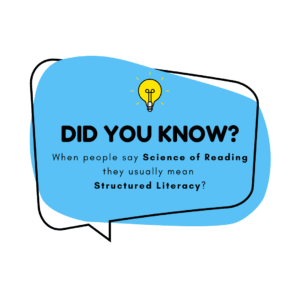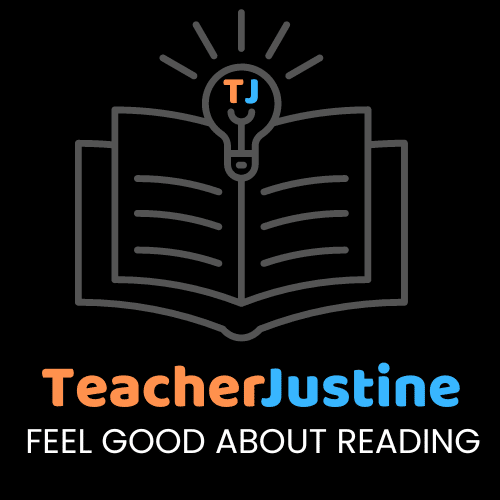Teacher Justine contains affiliate links and is a member of the Amazon Services LLS Associates Program. If you make a purchase using one of these Amazon links, I may receive compensation at no extra charge to you. See my disclosure policy for more information.
Is Your Child’s School Teaching Reading Wrong?
Sold a Story podcast is making teachers angry that they teach reading wrong
“I feel guilty and tricked.”
Group Member of The Facebook Group “The Science of Reading – What I Should Have Learned in College”
Teachers all across America are listening to Emily Hanford’s podcast, Sold a Story, and they feel angry. Angry that for the past 20 years they have been teaching reading based on a flawed idea.
Did this flawed idea teach your child to be a poor reader? How can you tell if your child is reading with the wrong strategies?
Sold a Story Podcast Background
Emily Hanford is an education reporter. In 2019 she wrote an investigative report called “How a flawed idea is teaching millions of kids to be poor readers”. She wrote about this because with kids home doing school on Zoom during the Pandemic, parents had a view into how their children were being taught to read. They were horrified. Hanford looked into it and discovered that kids were being taught to guess words by looking at pictures.
Now in Sold a Story, Hanford investigates further why schools have not been teaching kids to read. The story is fascinating. Throughout the 6 episodes, she traces the history of reading instruction in this country from the 1940s when the flawed idea began with Marie Clay. Then to the phonics vs. whole language reading wars in the late 1990s and early 2000s. And, to now where the reading wars are alive and well under the new names Science of Reading vs. Balanced Literacy.
The science of reading
Scientists became interested in the brain and reading in the 1970s. They proved that, unlike speaking, learning to read is not natural. The science showed that reading is a formidable challenge for 60% of people. And that most people need direct, systematic, explicit instruction in how letters, letter combinations, and syllables represent sounds.
But there is a pervasive belief underlying the reading curriculums in this country that reading is natural if supported by the environment. There is a belief that kids naturally learn to read if their parents read to them a lot. Or that if we create cozy reading nooks in schools with lots of books that kids will want to read and will figure it out.
Sold a Story shows how we have known the science for 50 years. But one publisher and its top authors dominate the marketplace with their curriculums. And they are having a hard time admitting they are wrong. They don’t want to give up their power and dominance in reading instruction.
Teachers are angry they were not taught the science
Because of Hanford’s reporting, teachers are learning about the science of reading and they are angry that they were never taught to teach reading in their teacher training. The Facebook Group “The Science of Reading – What I Should Have Learned in College” is exploding with teachers’ reactions to the podcast. Here are a few reactions out of thousands of angry comments from teachers:
“I feel that Sold a Story is a true crime podcast for educators. So many emotions after binging the first 5 episodes. I feel guilty and tricked.” –
Group Member of the Facebook group “The Science of Reading – What I should have learned in college”
“I am obsessed with the Sold a Story podcast. My school district would NOT approve of me listening to this and so far I only talk about it with one coworker that I’m comfortable with. The few times I’ve heard SOR come up in front of literacy coaches or admin, they brush it under the rug and don’t give us any information other than to say it’s wrong.”
Group Member of the Facebook group “The Science or Reading – What I should have learned in college”

There are literally thousands of teachers expressing similar feelings like this.
Balanced Literacy
Some districts are sending their teachers to Science of Reading trainings and they are making changes in their schools, but most are not. Teachers are begging to teach reading based on science. But districts have invested millions of dollars into their balanced literacy curriculums and teacher trainings and they can’t or won’t switch.
“I think it comes down to money. Districts have spent a fortune over BL.”
Group Member of the Facebook group “The Science of Reading – What I should have learned in college”
“And districts are afraid of being sued.”
Group Member of the Facebook group “The Science of Reading – What I should have learned in college”
“No one wants to be told they wasted money. It’s strange to me because I don’t even need science to tell me explicit instruction is better than teaching kids to guess. It seems like common sense to me.”
Group Member of the Facebook Group “The Science of Reading – What I should have learned in college”
Some teachers are being sent to training backed by the science of reading. And they are learning how to teach with a structured literacy approach. But then back in the classroom, they are still required to teach from the balanced literacy curriculums.
So how does all this affect your child’s reading instruction in school?
Despite the best efforts of teachers to bring change, many districts will continue to make teachers teach using balanced literacy curriculums. They assess reading using the Benchmark Assessment System and place students at a level from A to Z. Read this article from Reading Rockets to learn why the level means very little.
Then the teacher will give your child a baggie or box of books at their level and they will read their books independently. Many will be reading books that contain words that they can’t sound out. Since they are reading independently with no one listening to them read, they will continue to skip and misread words. The kids who struggle the most will be slowly flipping through the pages pretending to read.

When they are in their small groups, the teacher will be able to hear them read. But usually, these books have enough pictures and predictable text that the child will appear to be reading. If the teacher has only been trained in balanced literacy, they will continue to use guided reading to teach the child to guess using three-cuing. If the teacher has knowledge of phonics and the science of reading, they will help the child sound out the word. But they will teach phonics as errors occur, not in a systematic way.
Your child will continue to go up in levels. There are only 2 books at each level that the teachers use for assessment. If the student does not pass on accuracy the first time, they will the next time because they know the book. The comprehension questions are usually easy enough to get right even with inaccurate reading.
How to know if your child is reading wrong
Grade 3 and above:
Since your kids are probably in a balanced literacy school, ask them or their teacher what is their level. Find some books at this level. You can use the Scholastic Book Wizard to find books at your child’s level.
Now listen to your child read. What do you notice?
- Are they sounding out unknown words by looking at the letters from left to right? (Good)
- Or are they guessing words based on the predictable pattern of the text? (Bad)
- Are they guessing words by looking at the picture? (Bad)
- Do they notice when they have read the wrong word (Good) or do they just keep going (Bad)?
- Do they read in phrases that sound natural? (Good)
- Are they changing the word order without noticing? (Bad)
- Do they read in phrases that promote understanding? (Good)
- Do they pause and reread when something stops making sense? (Good)
- Do they read long unknown words syllable by syllable? (Good)
- Or do they read the first syllable and then say the first word that pops into their head? (Bad)
- Do they omit or add words? (Bad) Do they notice when they do this?
- Can they summarize what they have read? (Good)
- Are they reading too fast or too slow?
If you notice that your child skips words, changes words, omits words, or changes the word order, then your child is reading wrong. Even if they seem to have a basic idea of what they read, they are reading wrong. They have been taught that reading for meaning is more important than accuracy. Reading comprehension is the ultimate goal of reading, but reading inaccurately will not reveal the true meaning of the text.
Grades K-2:
For beginning readers, get some decodable books and listen to your child read. A decodable book is only decodable if the child has been taught the spelling patterns that appear in that book. Ask your child’s teacher what spelling patterns they have been taught. Ask them for some decodable books with these patterns or search online. What do you notice?
- Can they sound out simple one-syllable words? (Good)
- Have they mastered the alphabetic principle? (Good)
- Do they recognize automatically many high-frequency words? (Good)
- Are they using strategies like looking at the picture and guessing? (Bad)
If you notice they are sounding out words, they are on a good path. If you notice they are using strategies like guessing, they are starting to read wrong.
My child is reading wrong. Now what?
Grades 3 and above:
Inaccurate reading can be fixed. Have your child read a few pages out loud to you every day. When they come to an unknown word, make sure they slow down and read it syllable by syllable.
If they don’t know how to read words syllable by syllable, you can teach them where words normally divide into syllables. You can also teach them about syllable types and sight syllables. For more information on this, check out my free guide “How to get your child to stop guessing words.”
Daily oral reading will help your child begin to notice when they are misreading. If this practice causes too much stress or drama in your household, reach out to a tutor to help you. Find a tutor who knows about structured literacy. Kids usually do not get emotional when they are working with someone who is not their parent.
Grades K-2:
Talk to your teacher and ask if they have listened to the Sold a Story podcast. Ask them if they are using the 3-cuing system. Some teachers are very informed about the science of reading and structured literacy, but they might be prevented from making changes by their principal or district.
In a balanced literacy classroom, phonics probably was not taught following a scope and sequence so your child might have some gaps. Ask for a diagnostic assessment to find out which phonics skills they have not learned yet. Then teach these patterns to your child yourself or hire a tutor that uses structured literacy.
Above all, you want to make sure they don’t develop strategies like guessing.
Conclusion
It’s an exciting time to be teaching reading. But it is also an emotional time. Don’t blame the teachers. Teachers want to help kids learn to read. Many are paying for their own professional development in structured literacy. They are trying to get their schools to change. And because of this podcast, change is slowly happening. Find out how your child’s school is teaching reading. If they are still teaching reading wrong, get help.
IF YOUR CHILD IS
Struggling with Reading
I CAN HELP
